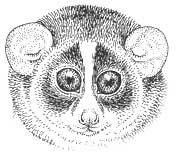
17
| Home |
|
|
Husbandry Manual for Asian
Lorisines
(Nycticebus & Loris ssp.)
| BEHAVIOR |
|
| Introduction |
|
| Social Behavior |
|
| Housing and Social Behavior |
|
| Aggressive Behavior |
|
| Loris Ethogram |
|
BEHAVIOR
There has been little behavioral research on wild populations in their natural habitat. The loris’ nocturnal, arboreal, and cryptic nature makes them difficult research subjects. Two behavioral field studies on the slender loris are currently being done in Southern India. Kabiri Kar-Gupta (1998) has been studying the Malabar slender loris L. malabaricus subspecies in Mundanthunai. Kimberley (Anna) Nekaris has studied the Mysore slender loris L. lydekkerianus in Madurai (Nekaris, 2000). Behavioral research on the slow loris has been done in the field by Barrett, 1984; and Wiens, 1995.
All lorises are nocturnal and eat a variety of fruits and vegetation in addition to insects, small mammals, and birds. Preliminary field data show that they are solitary with the home ranges of males overlapping those of females. During the day, lorises sleep in branches, crevasses or buried in leaf litter on the ground. Their normal sleeping posture is curled up with their heads tucked up between their thighs. All lorises communicate through olfaction and use urine to mark their territories. They drag their lower ends and leave a trail of urine on the branches as they travel. Slender lorises also perform a behavior known as “urine wash”: they rub their hands and feet in urine to spread their scent. Urine washing may also be used to keep skin moist for better traction while climbing, temperature regulation or displaced behavior of nervous or excited animals. Studies of lorises’ acoustic communication repertoire have recognized between six and eight different kinds of vocalizations. (See ethogram at the end of this chapter for a complete description of calls.)
This chapter provides an overview of captive loris behavior and
behavioral
management. For additional information, see the following sources:
Slow lorises: Ehrlich, 1968 a, b, 1969, 1974; Ehrlich and
Macbride,
1989; Ehrlich and Musicant, 1976, 1977; Gorter, 1937; Jaenicke and
Ehrlich,
1972; Ohta, 1983; Rasmussen, 1986a; Zimmermann, 1985, 1989;
Zimmermann
et al., 1979. Nycticebus pygmaeus: Fitch-Snyder, 2000.
Nycticebus
intermedius: Feng et al., 1992, 1993, 1994. Slender lorises:
Subramoniam,
1957; Rasmussen, 1986a; Goonon, 1993; Schulze and Meier, 1995b.
Lorises have historically been considered to be relatively solitary and non-social animals. Slow lorises are usually encountered alone in the wild, which makes an argument against extensive social affiliation. There has been one report of a group of six slow lorises found together (Elliott and Elliott, 1967). The group appeared to be five slow loris males following a female in estrus. In captive conditions, slow lorises are also known to mate with more than one male during a single estrus.
It has been suggested that lorises’ social system resembles their fellow prosimian Perodicticus potto, which is morphologically similar to the lorises. Female pottos have small territories which are overlapped by males’ larger territories (Charles-Dominique, 1977).
Slender lorises have been found in colonies in areas otherwise free of lorises (Schulze and Meier, 1995b). The colonies consisted of very small adjacent territories, sometimes comprising little more than a tree. The number of individuals in the colony varied depending upon food availability. Slender lorises travel distances of 20-30 meters per night, usually moving alone or in pairs (Petter
14
Ehrlich and Musicant, (1977) have questioned the view that lorises are solitary, since captive slow lorises show a high degree of associativeness and a relative lack of aggression. They also often exhibit play and grooming behaviors.
The Zimmermanns (1979) also believe that the behavioral repertoire of the slow lorises and the small quantity of aggression in family groups indicate that they live in some type of social groups. The slow lorises exhibit tactile forms of communication and use contact calls. Other researchers also question the idea of the lorises’ supposedly solitary lives in the wild since they appear to be ‘contactloving.’ Grapple behavior is manifested in a playful context (Trent et al., 1977).
Availability of food may influence social behavior. The orangutan (Pongo pygmaeus) is an arboreal primate, which has been studied more in the wild than lorises. It is also considered a solitary animal with overlapping territories. Food availability and number of competitors determine the size of the home ranges. The males’ distributions are adapted to ovulating females’ spatial and temporal distribution. Territorial defense has the greatest reproductive advantage relative to energy cost. Orangutans, however, are capable of strong social attachments (Maple, 1980). Individuals can form temporary associations and a network of relationships exists. Rikjsen (1978) defines their lifestyle as “limited gregarious.” He believes that the solitariness has evolved due to human competition and predation pressure, rendering the orangutans less conspicuous when solitary. It is likely that these observations may also be generalized to lorises; however, more information is needed to clarify the extent of sociability in each loris species.
Lorises apparently have a surprisingly well-developed social
behavior
system, although behavioral properties of group-living simians,
such as
establishing a rank order, are apparently absent.
Housing and Social Behavior
The number of animals kept together varies from institution to institution. Ruhr University reports that pairs and family groups of up to eight slender lorises live peacefully together in their facilities. In some groups, mothers and adult daughters are kept together with one sire unrelated to all females. Slow lorises have been successfully housed this way at San Diego and other zoos. Pregnant females are removed to prevent possible aggression towards the infants. This type of housing resembles the suggested wild social structure with adjacent female territories overlapped by a male’s larger territory. Continuous social housing may not correspond to lorises natural social system in the wild, but it may reduce the boredom of solitary housing.
Attempts to house trios (two females with one male) are not always successful and may conclude with the removal of one of the females (Bertram, 1984). Adelaide Zoo reported that two of their slender loris females formed a coalition against the male, forcing separation due to increased aggressive behavior between them and the male (Goonan, 1993). However, the trio had been housed together for several years before this development. Duke University had a similar experience with a trio of slender lorises. They were forced to separate the animals after the females began to fight. This group had been housed together for four months (Weisenseel, 1986). Social groupings may work well for long periods of time before unexplained aggression occurs. Conversely, lorises that may not have been compatible at one stage of their lives may get along later if reintroduced at another time or
15
under different housing conditions. Like most other primates, individual temperaments, background, and housing conditions must all be considered.
Most commonly, lorises are kept in breedable pairs. It is advisable for juvenile offspring to be transferred before they become sexually mature so that they do not interfere with further reproduction. Duke University separates their male juveniles at nine months and suggests separation for both genders at eight to ten months. If large cages are available, the animals can remain together for longer periods and be kept in larger groups.
Some institutions prefer to keep lorises separate to minimize the risk of injury from aggressive interactions. In these situations, pairs are only introduced when the female is in estrus. If the pair gets along well, they may remain together.
Ehrlich and Musicant (1977) deemed agonistic behavior relatively rare according to a study on slow lorises. Most agonistic encounters did not appear serious, and wounds were usually not inflicted. Participants frequently did not separate once the agonistic situation concluded; instead, they would engage in social grooming or play. Because the animals in their study were observed in fairly large enclosures, space may have played a role in their peaceful behavior. Rasmussen (1986b) found that small cage size may contribute to high levels of aggression.
Aggression most frequently occurs when several adults of either sex are housed together; mature offspring are housed with the parents; and females are housed with adult males. Aggression between heterosexual pairs can occur when a male becomes agitated after repeated attempts to copulate with an unreceptive female.
Daschbach et al. (1983) and Weisenseel (1986), found that male slow lorises that remain with their parents beyond adolescence may become more aggressive as adults. However, there is little evidence from other institutions to support this theory. In all three species, young males have remained with parents beyond adolescence without becoming aggressive.
Wounds received during attacks are usually found in two distinct regions on slow and pygmy lorises: the scalp and back of the head and neck, or on the thighs, rump and ano-genital region. The dorsal regions are exposed when the lorises exhibit their defense posture, which is to roll their heads down between their front legs and present an open mouth behind an armpit. The posterior regions are exposed when fleeing, and could be a center of focus because they emanate olfactory information (Rasmussen, 1986b). Other regions that often receive wounds during attacks are the face and arms. Slender lorises’ wounds are mostly on the lower arms and hands.
Hunger can lead to general stress that sometimes results in fighting among slender lorises (Meier et al., unpublished). Providing more than one food bowl or serving smaller, more frequent portions may help alleviate this problem. Aggression is usually not seen between lorises while feeding, even when they are trying to steal certain choice items from one another (Goonan, 1993).
Lorises should be introduced under the least stressful conditions possible. The animals should be paired after they have finished feeding and are relaxed. There should also be plenty of areas where
16
To reduce aggression when introducing a pair, the following strategies are suggested. 1) Introduce the male into the female’s enclosure, or introduce both of them in an unfamiliar enclosure. 2) Use introductory housing so that the animals become familiar with each other. The male should go into a smaller cage within the female’s larger cage, or a tunnel could connect two adjacent cages. The pair should be closely monitored for initial aggression and biting through wire. (A plexi-glass divider or double-wire screen may be used, however, the pair should have the opportunity to smell each other before they are actually placed together). 3) Introduce the pair when the female is in estrus.
A novel method used in Bochum to introduce slender lorises
consists
of two adjacent cages that have sleeping areas separated by wire
mesh.
These areas are furnished with highly favored sleeping materials
such as
leaves and a localized heat source. The lorises get used to
sleeping close
to each other through the wire, and they behave as though they
have always
been together when the wire mesh is later removed.

17
![]() Loris
Husbandry Manual
Loris
Husbandry Manual
Individual Behaviors
| Eat | Ingest food, normally by grabbing food item with one hand and take it to mouth. |
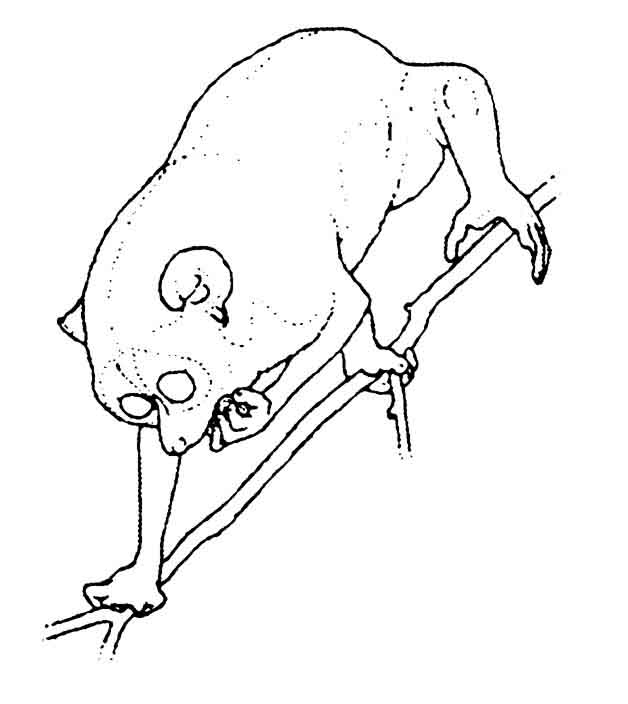
| Drink | Lap from surface. Some lorises dip a hand in liquids then lick the hand. |
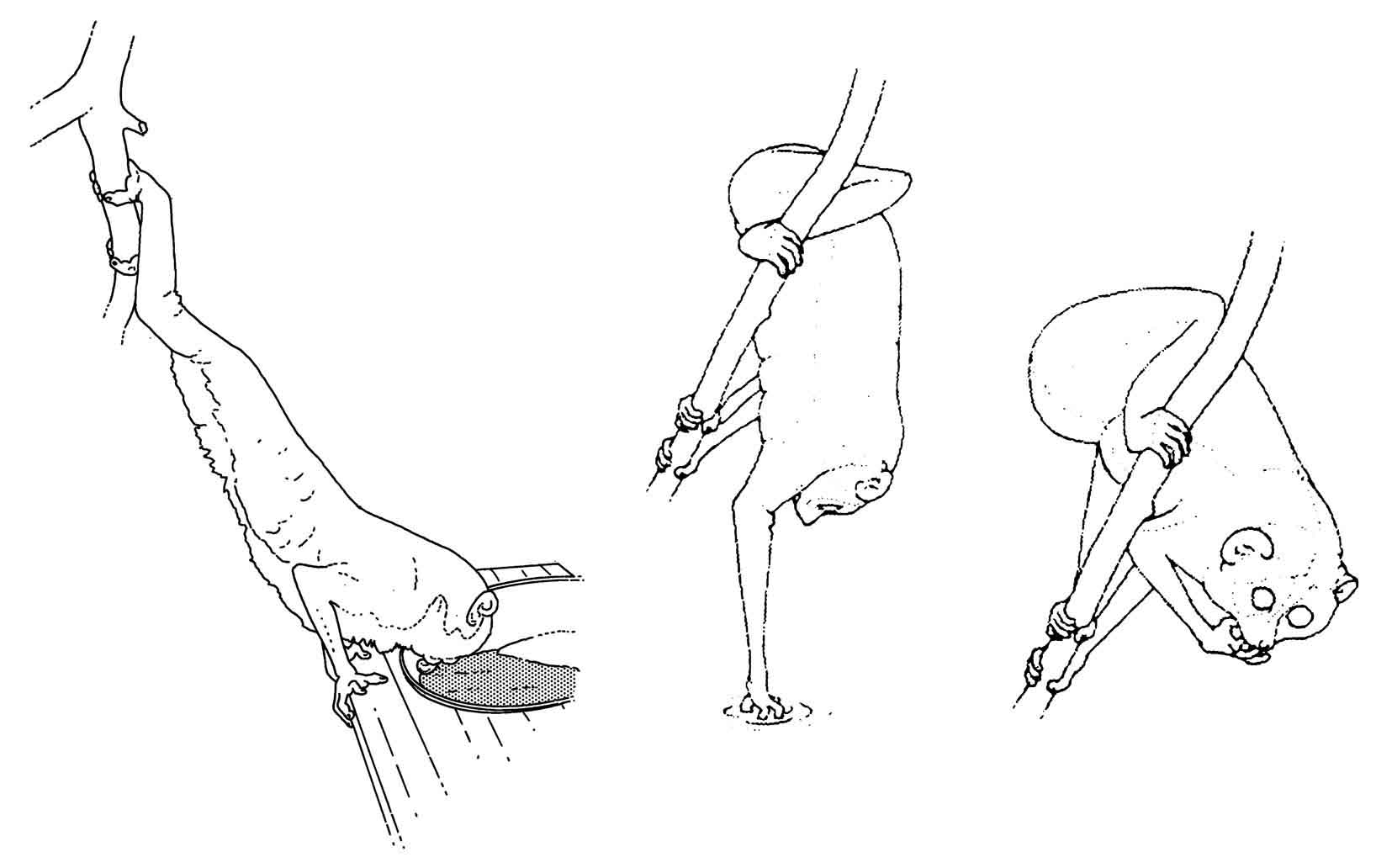
| Stand | Remain stationary in upright position using all four limbs. |
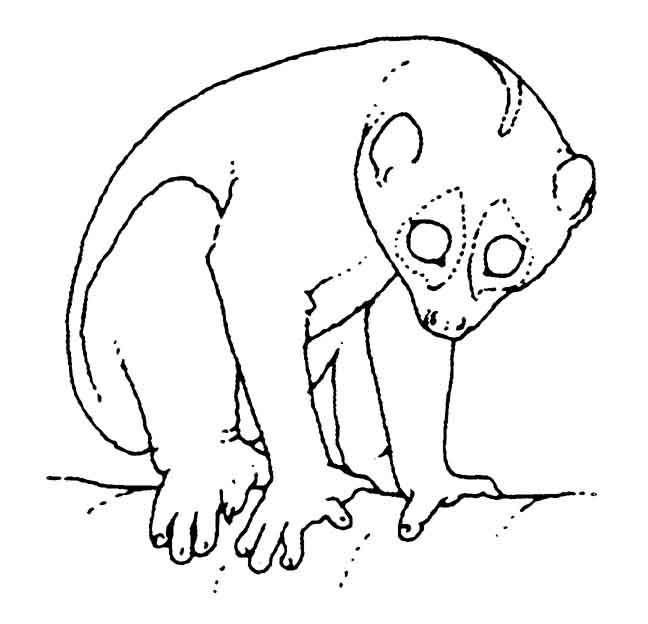
18
| Sit | Remain stationary with body hunched and head erect. |
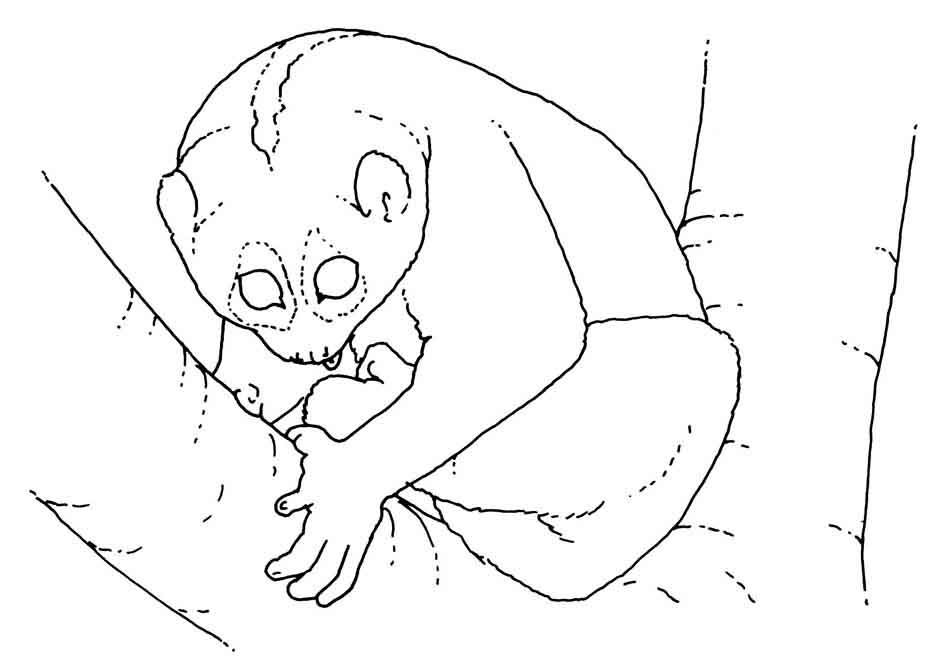
| Hanging | Hanging with one or two feet. |
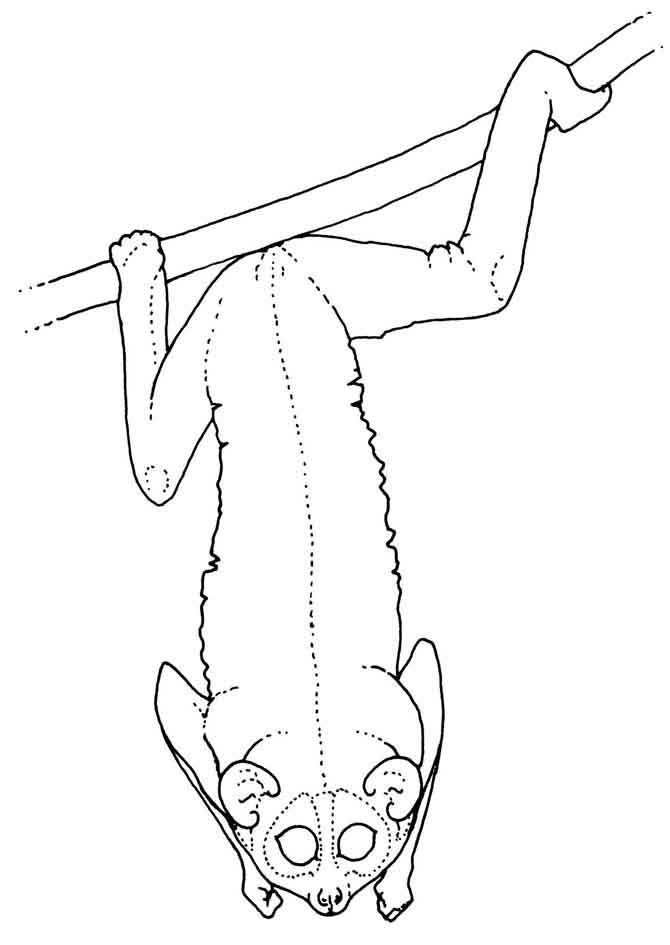
| Rest | Remain stationary with body hunched. Head between the knees when sleeping. |
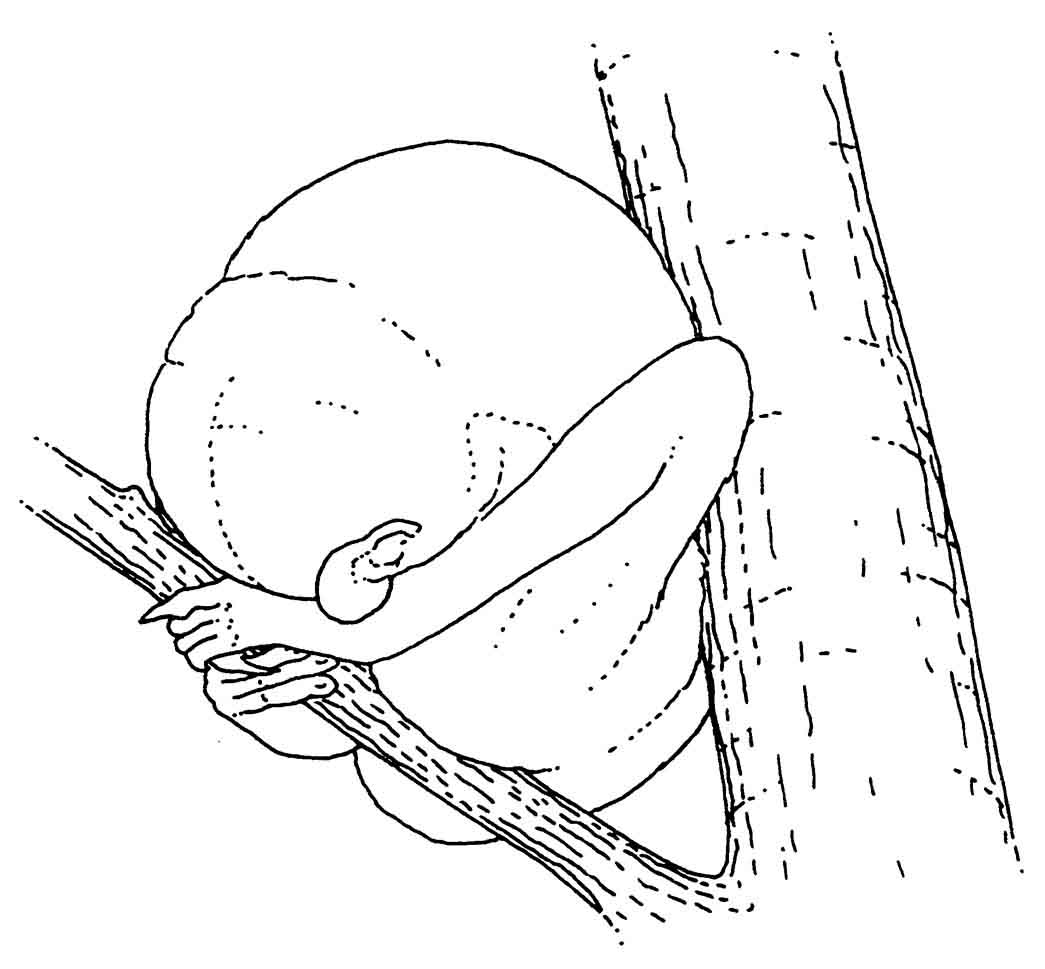
| Locomote | Move quadrupedally in any direction. |
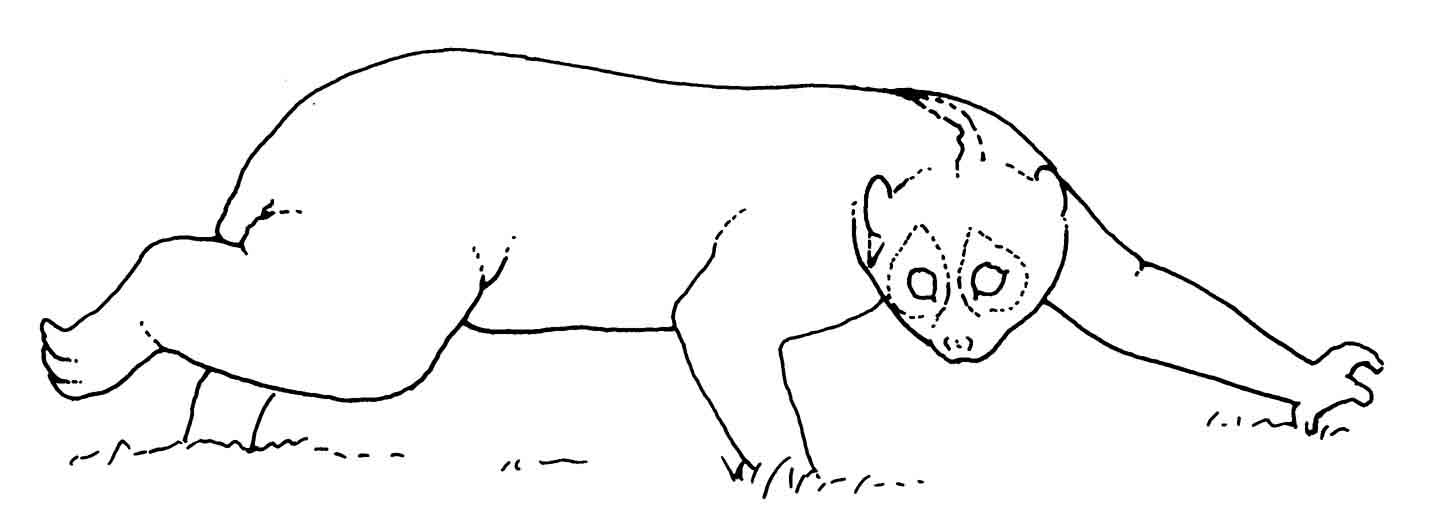
19
![]() Loris
Husbandry Manual
Loris
Husbandry Manual
| Back Away | Locomote in reverse while maintaining eye contact with the stimulus. |
| Flight | Rapid withdrawal from stimulus. |
| Climbing | Locomotion on any non-level surface in enclosure. |
| Rear | Stand on two legs. |

| Explore object | Approach, sniffing, exploration by prey-catching hand-grabs. No urine marking. |
| Explore cage | Climb around the cage, sniffing and urine marking. |
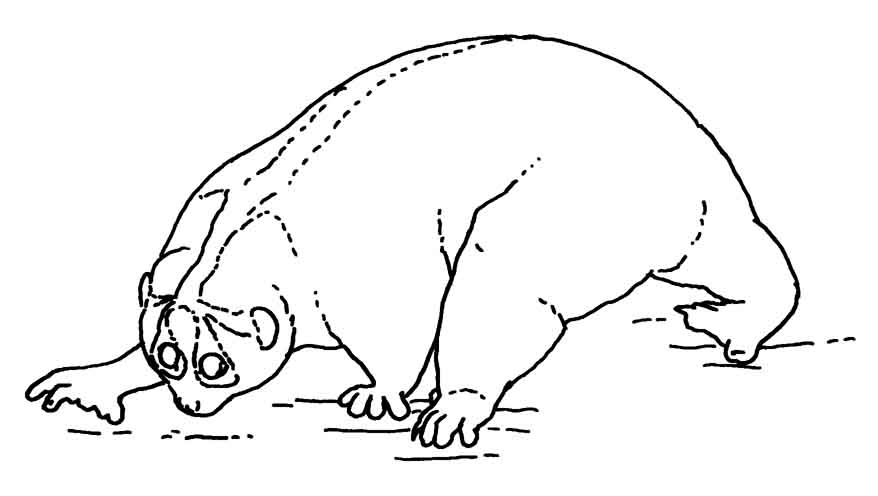
| Pace | Repeated rapid locomotion within a restricted area. |
| Sniff | Apply nose to objects in environment including floors, walls, dowels, etc. |
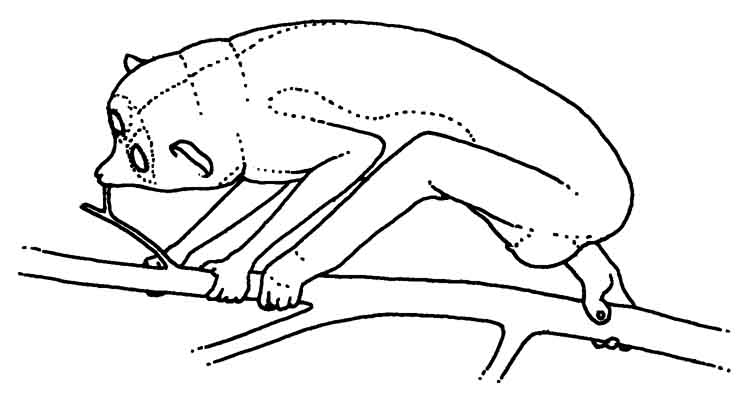
| Crouch | Arch body and bring ventral surface to substrate. Social stress posture. |
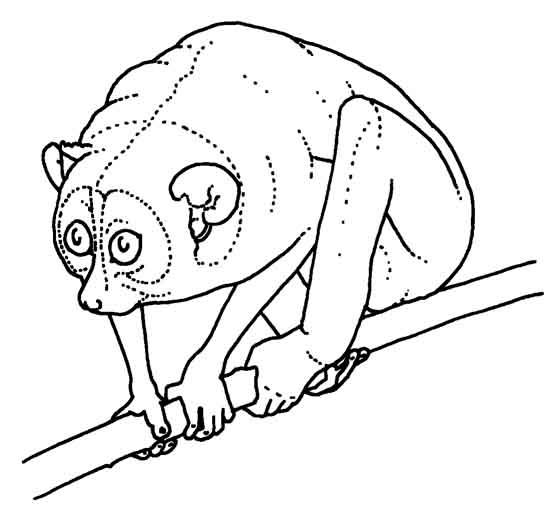
20
| Freeze | Interrupt locomotion to maintain motionless, rigid posture in standing or sitting position for at least three seconds. Sign of disturbance, environmental stress |
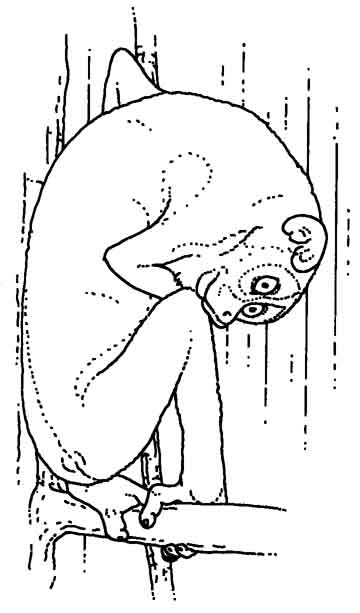
| Auto-groom | Lick or use tooth comb on own fur. |

| Self-scratch | Self scratch with grooming claw. |
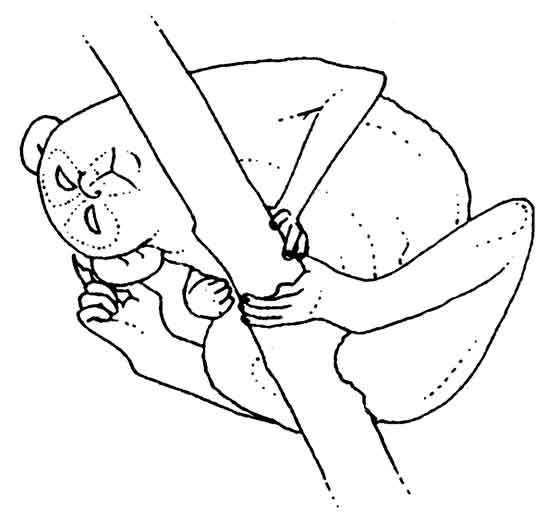
| Facial Rubbing | Vigorous rubbing of the snout, chin, cheeks,
or neck on
a substrate/object.
(Not seen in slender lorises.) |
| Rubbing arms | Rub head against arms. |
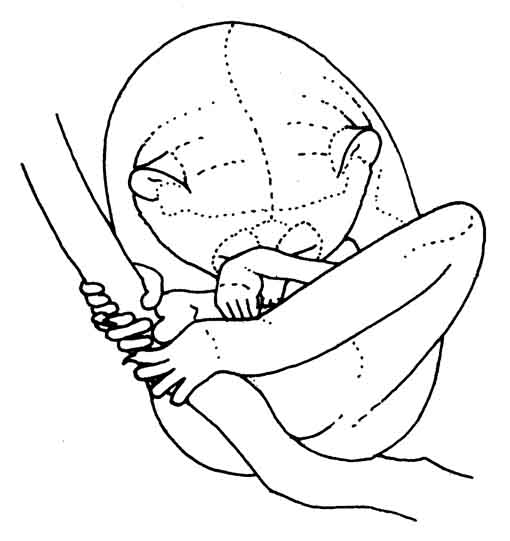
21
| Urine mark | Lower hindquarters and urinate while locomoting. Infants do not usually perform this behavior. |
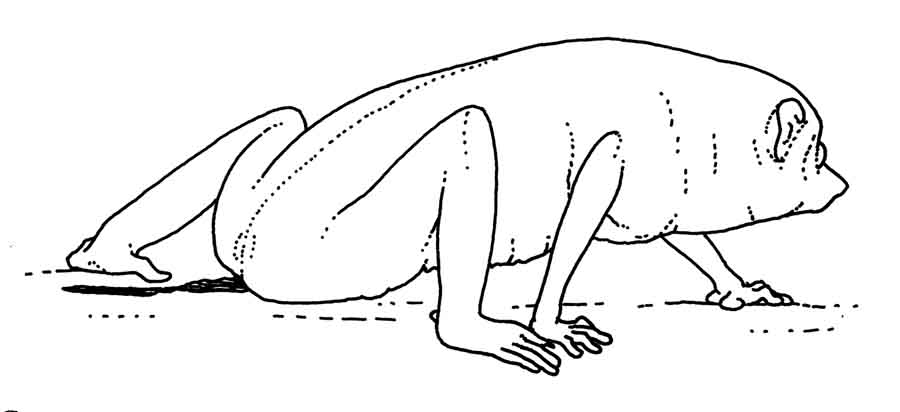
Social Behaviors
| Approach | Move toward other animal to less than one body length away. |
| Incomplete approach | Move toward other animal, but stop more than one body length. Usually in response to threat. |
| Approach-pass | Move within one body length of other animal and then continue to pass without pause. |
| Leave | Deliberate movement away from the other animal during an ongoing social interaction. |
| Follow | Climb behind another loris and maintain visual orientation to it. |
| Proximity | Sit, stand or rest within one body length of another animal without engaging in social activity. |
| Depart | Move more than one body length away from another animal after any physical contact. |
| Contact | Bodies touching but no clasping or other social behavior. |
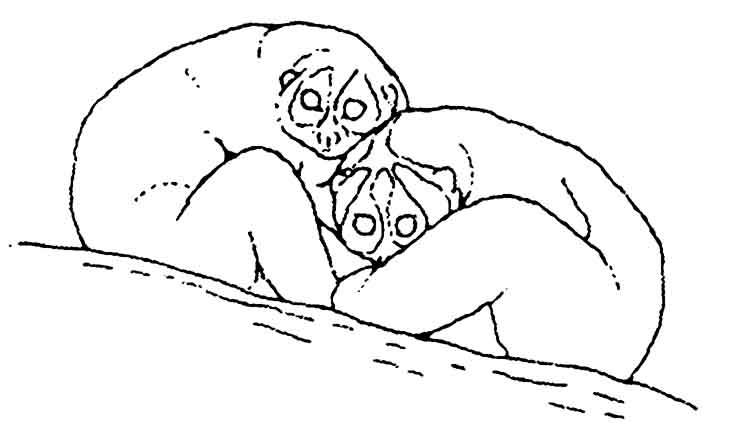
| Social Explore | Sniff body of another animal. |
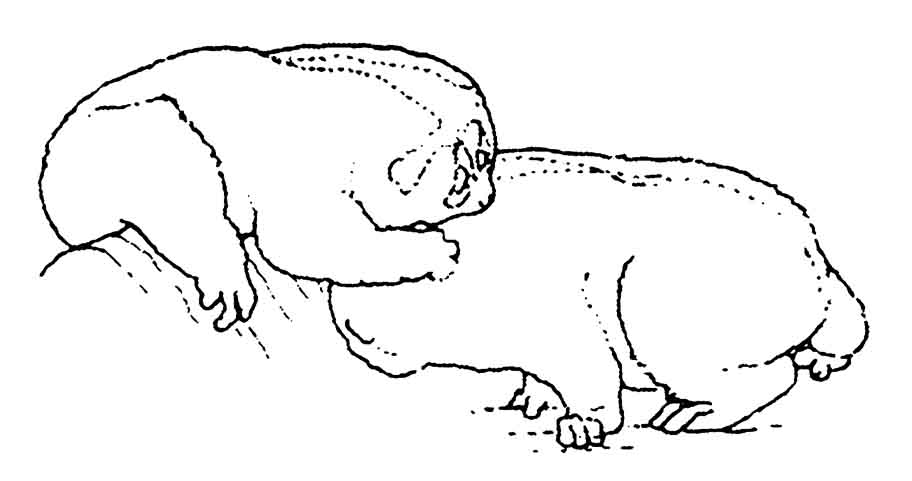
22
| Social Play | Attempted bite or manual attack, dangle by feet, wriggle body with arms over head. Play-fight episodes last up to a half-hour with neither animal trying to get away and never end with flight or signs of subordinance. Often interrupted by social grooming. No vocalizations as when fighting. |
 |
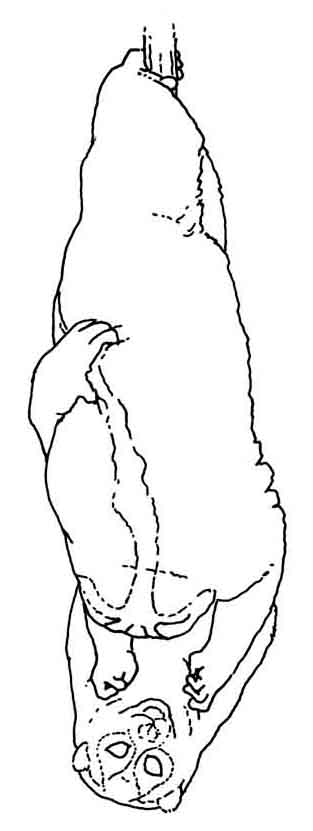 |
| Play Solicit | Hanging from the ceiling or a branch with wiggle motion. Arms usually outstretched. The posture in illustration may be used to apply brachial gland exudate to head. |
| Solicit | Female hangs from the ceiling or a branch by all four limbs, focusing attention on the male. In the slow and pygmy loris this posture is accompanied by high pitched whistling vocalizations. |
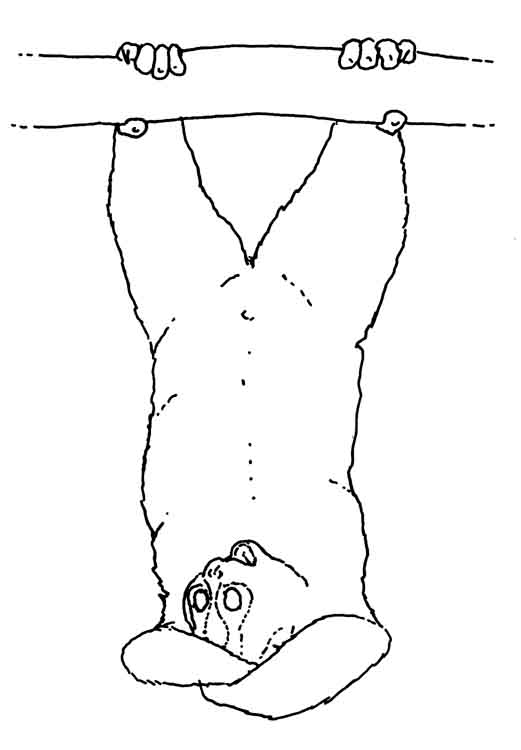
| Clasp | Grab another animal’s fur tightly with hands. |
23
![]() Loris
Husbandry Manual
Loris
Husbandry Manual
Allo-groom Lick or comb with toothcomb other
loris’ face
or fur - usually while clasping him or her.
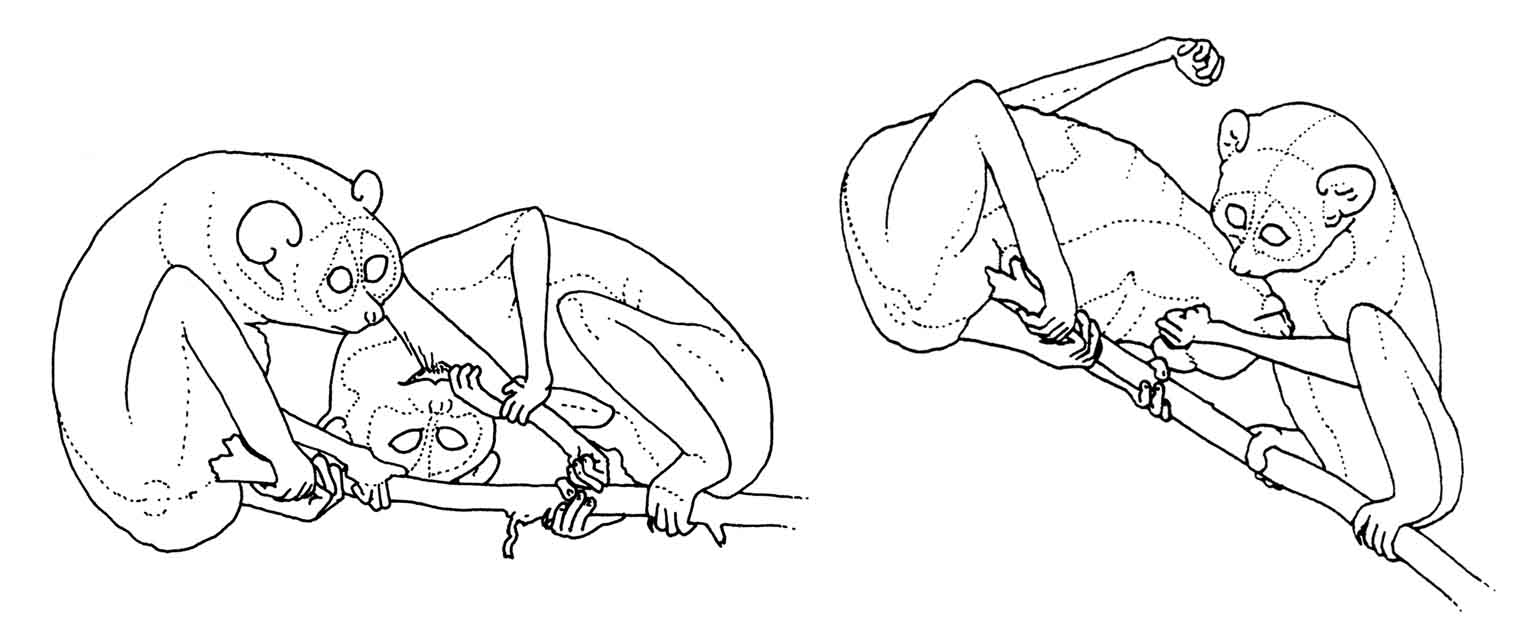
| Inverted embrace | Embrace while one animal hangs upside down and the other is in the upright position while clasping and licking the partner’s genital area. Not observed with slender loris. |
| Sniff/Lick | Close inspection of partner’s genital area with either sniffing or licking. |
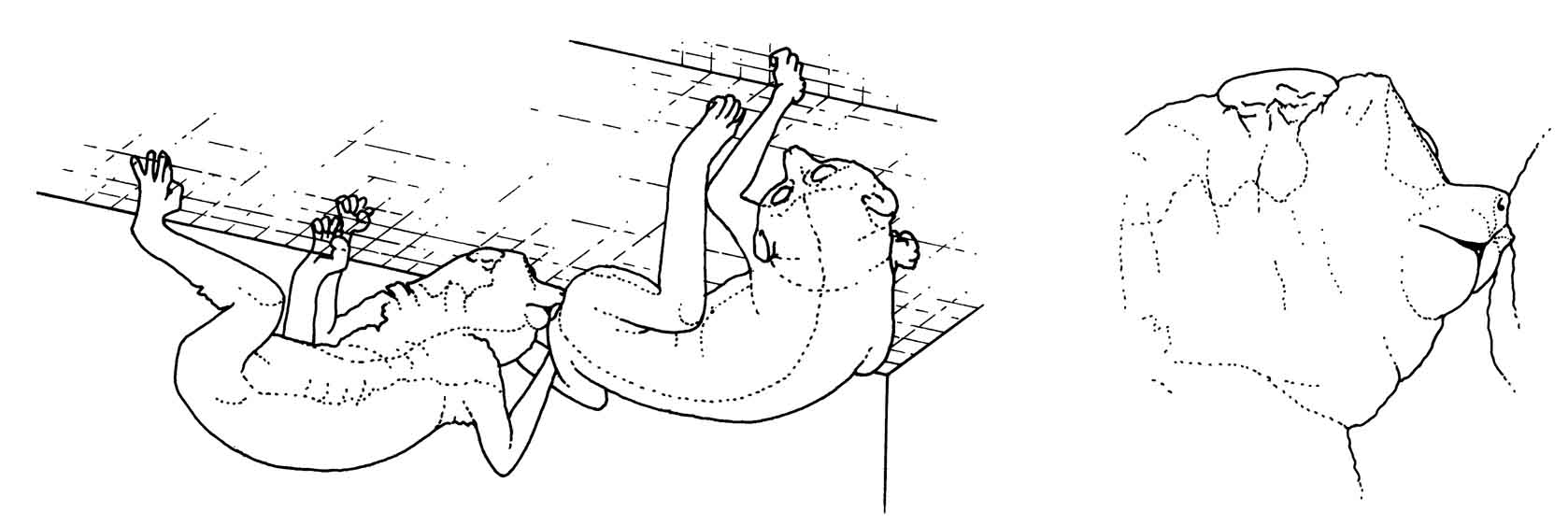
| Mount attempt | Mount and withdraw without repeated thrusting movements. |
| Copulation | Female hangs on a branch or cage wire and the male mounts her while dorsally clasping her sides and making rapid thrusting movements. In slender lorises, male makes lateral wiping movements on female’s back with his chin. |
Agonistic and Response Behaviors
| Attack | Feet stationary while head and neck are thrust suddenly at opponent. |
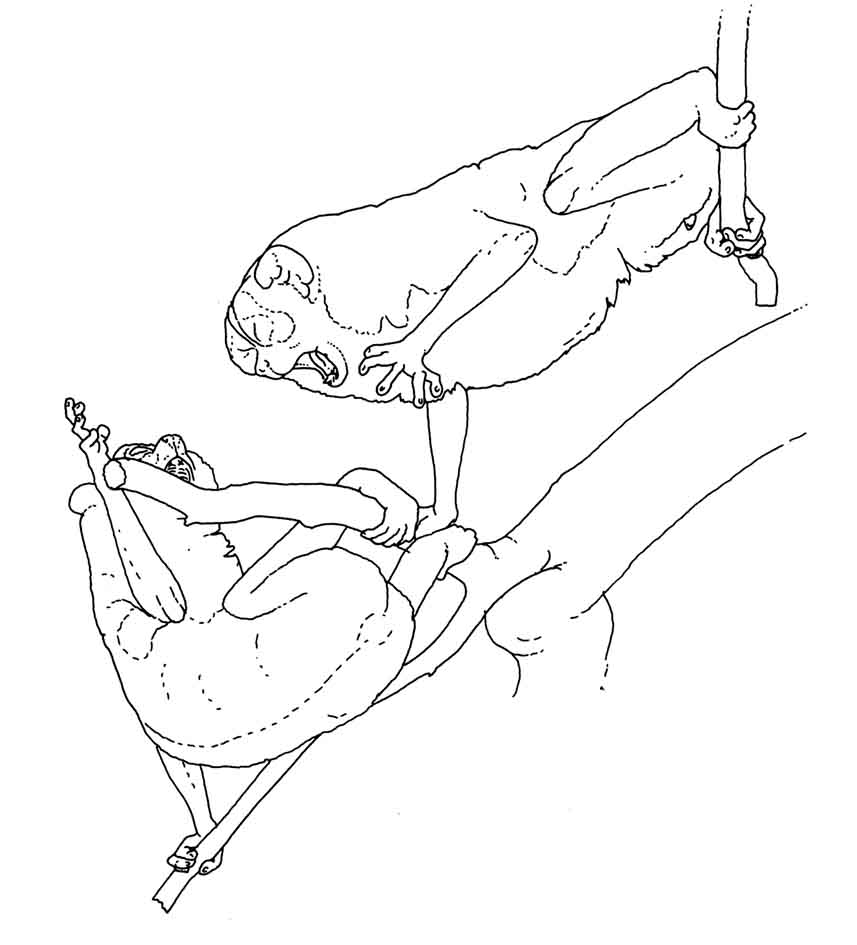
24
| Manual defensive threat | Push, pull and strike with hands. |
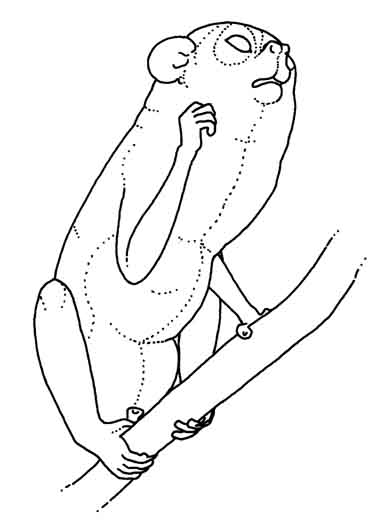
| Fight | Form of wrestling in which two animals manually attack and bite each other. |
| Threat | Attempted bite, attempted manual attack, lunge with open mouth. Staring at the opponent with chitters or growl vocalizations. Also, quiet staring in connection with slow approach preceding attack. |
| Aggressive Pursuit | Vigorous chase combined with attack or threat, particularly staring. |
| Assertion | Snatch away or share food with another. |

| Submissive Posture | Turn head and/or body away, usually of short duration before retreat. |
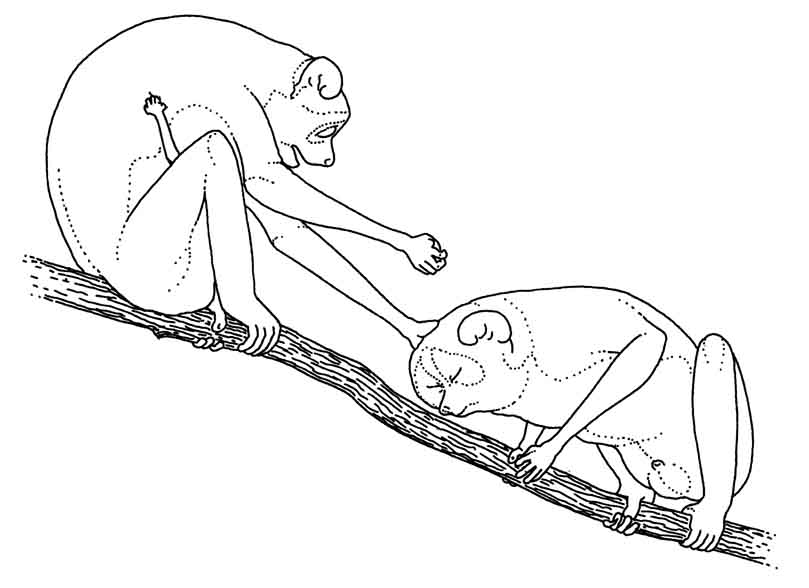
| Flight | Rapid, undirected withdrawal; Often downwards during social stress. |
| Back away | Locomote backwards while maintaining visual orientation to other animal. |
25
Mother-Infant Behaviors
| Ventral-ventral | Infant clings to the mother’s body. |

| Huddle | Mother hunched over infant and no manual contact between the pair. |
| Attempt ventral | Infant tries to push under the mother but she resists. |
| Grasp | Infant reaches and touches/grabs mother without clinging onto her body. |
| Climb on | Infant grasps and moves around on mother’s body. |
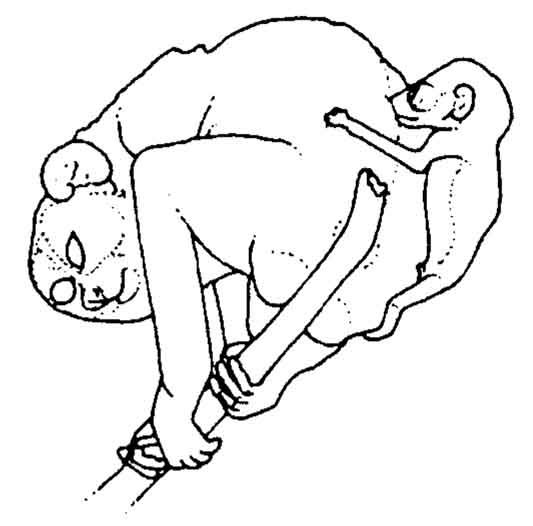
| Ventral-Dorsal | Infant on mother’s back. |

| Head block | Mother lowers head to chest and prevents ventral contact. Occurs during maternal rejection. |
| Inverted holding | Mother hangs from branch or wire with two or more limbs while supporting infant on ventrum. |
| Park | Mother removes infant from her body and leaves it. |
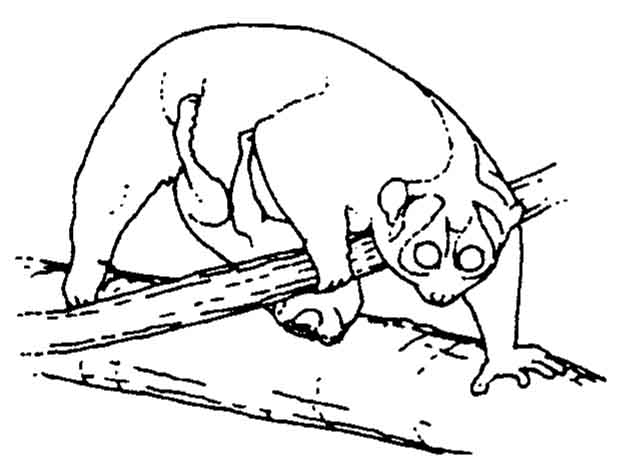
26
| Whistle | A high-pitched, non-directional sounding vocalization emitted usually by a receptive slow or pygmy loris female (open mouth). Territorial defense for slender loris. |
| Krik | Low and short, single or repeated at irregular intervals. Used to appease, usually by male pursuing female in estrus or females appeasing an infant. |
| Pant | Heavy rapid breathing, usually by an excited male. Not done by slender lorises. |
| Pant-growl | Panting, ending in a distinct growl, accompanying threats and preceding an attack. Not done by slender lorises. |
| Chitter (Kecker) | Rapid clicking sound, lasting one to two seconds or longer. Intraspecific defense vocalization. Can turn into cricket-like chirping in high intensity defense situations. |
| Click (Zic) | Series of discrete, rapid clicks and squeaks made by an infant during a disturbance, especially when separated from mother. May be followed by a short pant-growl. |
| Scream | Loud, high-pitched call uttered when seized by humans or by a submissive animal when bitten during a fight. Followed by rapid retreat. |
Behavior specific to Slender Loris
| Urine wash | Urine-mark into palm of hand, rub foot with hand, sometimes licking hand afterwards. (Also done by Galago.) |
27
|
Management
of Lorises in Captivity. A Husbandry Manual for
Asian Lorisines (Nycticebus
& Loris ssp.)
Edited by: Helena Fitch-Snyder and Helga Schulze. Compiler: Lena C. Larsen |
Last amendment: 2 January 2003 |